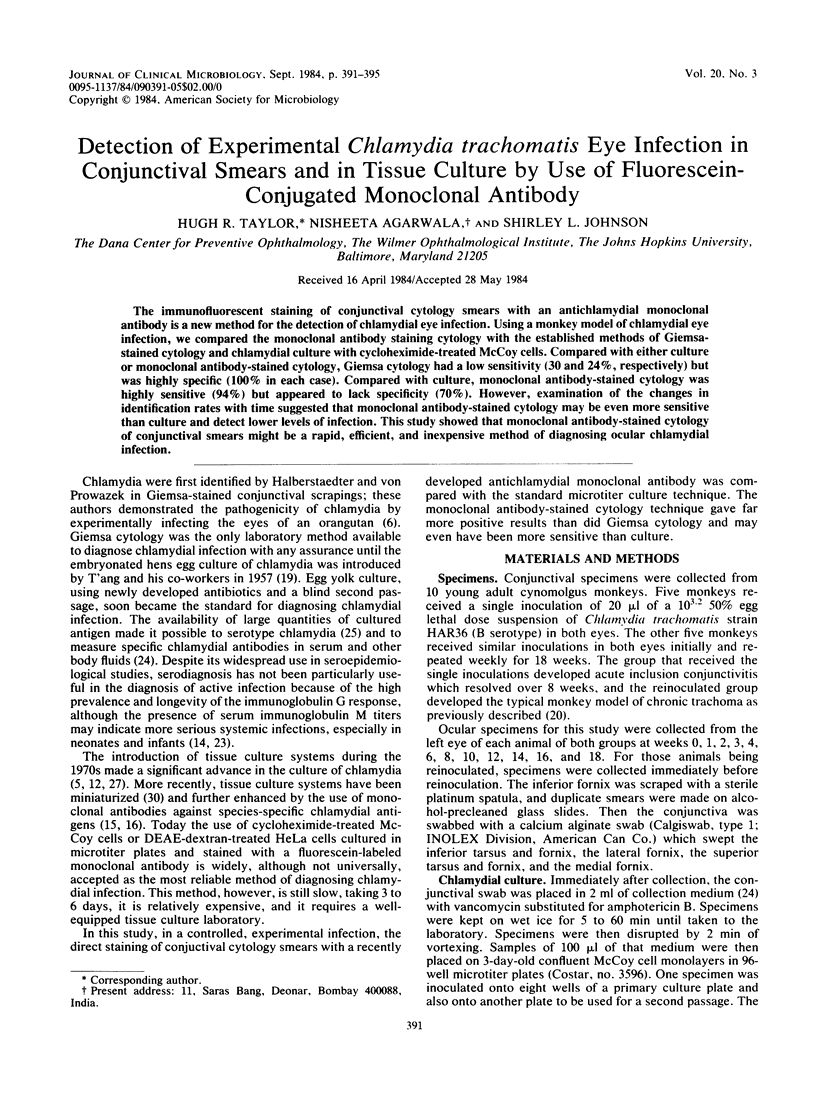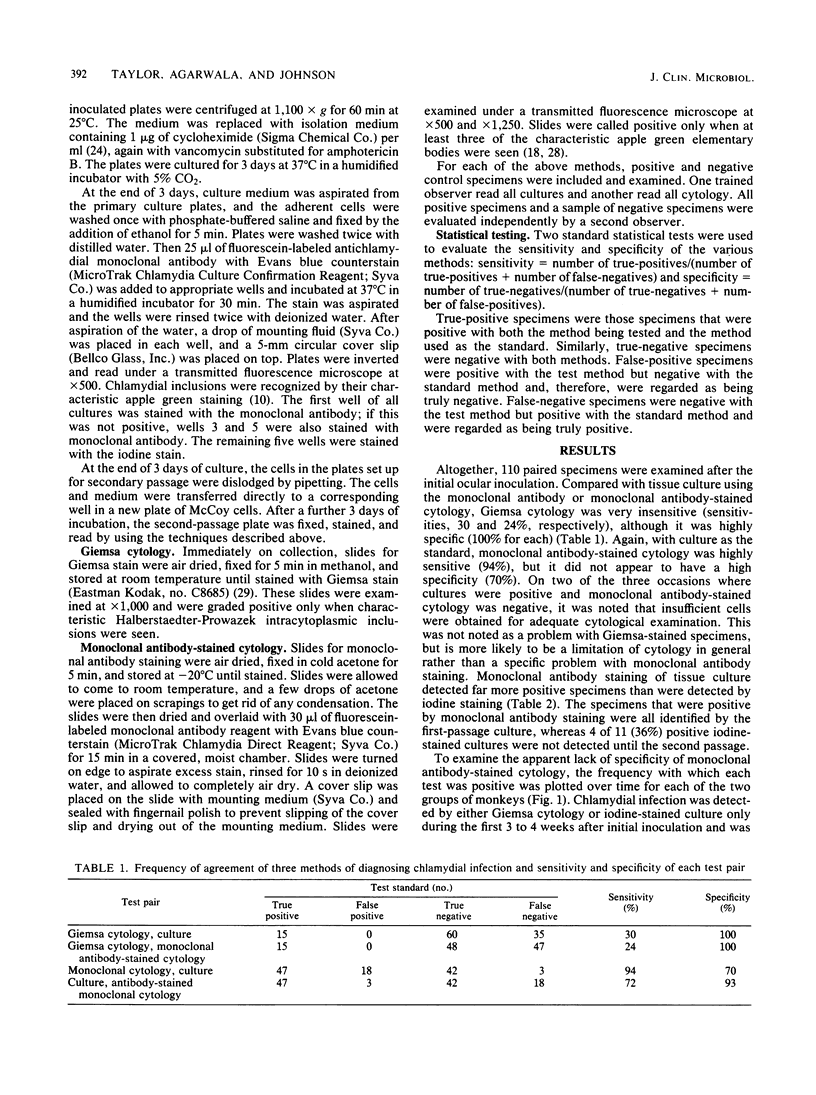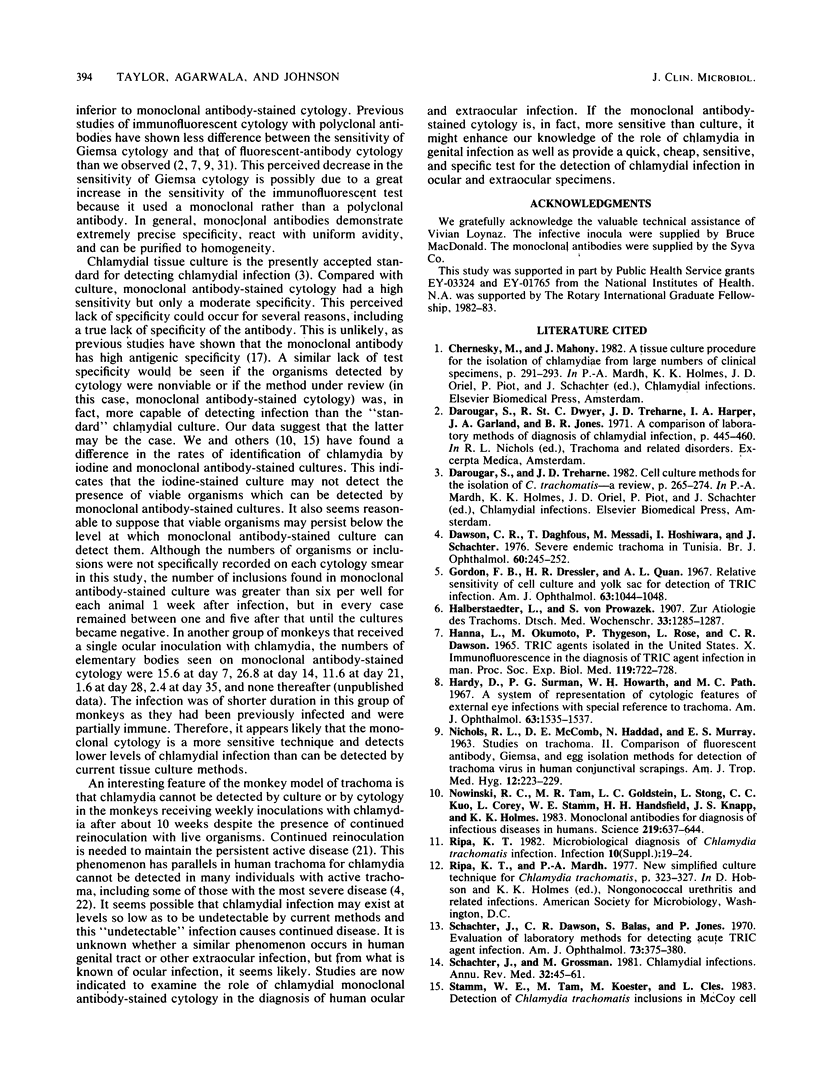Abstract
The immunofluorescent staining of conjunctival cytology smears with an antichlamydial monoclonal antibody is a new method for the detection of chlamydial eye infection. Using a monkey model of chlamydial eye infection, we compared the monoclonal antibody staining cytology with the established methods of Giemsa-stained cytology and chlamydial culture with cycloheximide-treated McCoy cells. Compared with either culture or monoclonal antibody-stained cytology, Giemsa cytology had a low sensitivity (30 and 24%, respectively) but was highly specific (100% in each case). Compared with culture, monoclonal antibody-stained cytology was highly sensitive (94%) but appeared to lack specificity (70%). However, examination of the changes in identification rates with time suggested that monoclonal antibody-stained cytology may be even more sensitive than culture and detect lower levels of infection. This study showed that monoclonal antibody-stained cytology of conjunctival smears might be a rapid, efficient, and inexpensive method of diagnosing ocular chlamydial infection.
Full text
PDF




Selected References
These references are in PubMed. This may not be the complete list of references from this article.
- Dawson C. R., Daghfous T., Messadi M., Hoshiwara I., Schachter J. Severe endemic trachoma in Tunisia. Br J Ophthalmol. 1976 Apr;60(4):245–252. doi: 10.1136/bjo.60.4.245. [DOI] [PMC free article] [PubMed] [Google Scholar]
- Gordon F. B., Dressler H. R., Quan A. L. Relative sensitivity of cell culture and yolk sac for detection of TRIC infection. Am J Ophthalmol. 1967 May;63(5 Suppl):1044–1048. doi: 10.1016/0002-9394(67)94080-9. [DOI] [PubMed] [Google Scholar]
- HANNA L., OKUMOTO M., THYGESON P., ROSE L., DAWSON C. R. TRIC AGENTS ISOLATED IN THE UNITED STATES. X. IMMUNOFLUORESCENCE IN THE DIAGNOSIS OF TRIC AGENT INFECTION IN MAN. Proc Soc Exp Biol Med. 1965 Jul;119:722–728. doi: 10.3181/00379727-119-30282. [DOI] [PubMed] [Google Scholar]
- Hardy D., Surman P. G., Howarth W. H. A system of representation of cytologic features of external eye infections with special reference to trachoma. Am J Ophthalmol. 1967 May;63(5 Suppl):1535–1537. doi: 10.1016/0002-9394(67)94143-8. [DOI] [PubMed] [Google Scholar]
- NICHOLS R. L., McCO MB D. E., HADDAD N., MURRAY E. S. Studies on trachoma. II. Comparison of fluorescent antibody, giemsa, and egg isolation methods for detection of trachoma virus in human conjunctival scrapings. Am J Trop Med Hyg. 1963 Mar;12:223–229. [PubMed] [Google Scholar]
- Nowinski R. C., Tam M. R., Goldstein L. C., Stong L., Kuo C. C., Corey L., Stamm W. E., Handsfield H. H., Knapp J. S., Holmes K. K. Monoclonal antibodies for diagnosis of infectious diseases in humans. Science. 1983 Feb 11;219(4585):637–644. doi: 10.1126/science.6297006. [DOI] [PubMed] [Google Scholar]
- Schachter J., Dawson C. R., Balas S., Jones P. Evaluation of laboratory methods for detecting acute TRIC agent infection. Am J Ophthalmol. 1970 Sep;70(3):375–380. doi: 10.1016/0002-9394(70)90097-8. [DOI] [PubMed] [Google Scholar]
- Schachter J., Grossman M. Chlamydial infections. Annu Rev Med. 1981;32:45–61. doi: 10.1146/annurev.me.32.020181.000401. [DOI] [PubMed] [Google Scholar]
- Stamm W. E., Tam M., Koester M., Cles L. Detection of Chlamydia trachomatis inclusions in Mccoy cell cultures with fluorescein-conjugated monoclonal antibodies. J Clin Microbiol. 1983 Apr;17(4):666–668. doi: 10.1128/jcm.17.4.666-668.1983. [DOI] [PMC free article] [PubMed] [Google Scholar]
- Stephens R. S., Kuo C. C., Tam M. R. Sensitivity of immunofluorescence with monoclonal antibodies for detection of Chlamydia trachomatis inclusions in cell culture. J Clin Microbiol. 1982 Jul;16(1):4–7. doi: 10.1128/jcm.16.1.4-7.1982. [DOI] [PMC free article] [PubMed] [Google Scholar]
- Stephens R. S., Tam M. R., Kuo C. C., Nowinski R. C. Monoclonal antibodies to Chlamydia trachomatis: antibody specificities and antigen characterization. J Immunol. 1982 Mar;128(3):1083–1089. [PubMed] [Google Scholar]
- TANG F. F., CHANG H. L., HUANG Y. T., WANG K. C. Studies on the etiology of trachoma with special reference to isolation of the virus in chick embryo. Chin Med J. 1957 Jun;75(6):429–447. [PubMed] [Google Scholar]
- Taylor H. R., Johnson S. L., Prendergast R. A., Schachter J., Dawson C. R., Silverstein A. M. An animal model of trachoma II. The importance of repeated reinfection. Invest Ophthalmol Vis Sci. 1982 Oct;23(4):507–515. [PubMed] [Google Scholar]
- Thygeson P., Dawson C. R. Trachoma and follicular conjunctivitis in children. Arch Ophthalmol. 1966 Jan;75(1):3–12. doi: 10.1001/archopht.1966.00970050005003. [DOI] [PubMed] [Google Scholar]
- Wang S. P., Grayston J. T. Immunologic relationship between genital TRIC, lymphogranuloma venereum, and related organisms in a new microtiter indirect immunofluorescence test. Am J Ophthalmol. 1970 Sep;70(3):367–374. doi: 10.1016/0002-9394(70)90096-6. [DOI] [PubMed] [Google Scholar]
- Wentworth B. B., Alexander E. R. Isolation of Chlamydia trachomatis by use of 5-iodo-2-deoxyuridine-treated cells. Appl Microbiol. 1974 May;27(5):912–916. doi: 10.1128/am.27.5.912-916.1974. [DOI] [PMC free article] [PubMed] [Google Scholar]
- Wingerson L. Two new tests for chlamydia get quick results without culture. JAMA. 1983 Nov 4;250(17):2257–2259. [PubMed] [Google Scholar]
- Yoneda C., Dawson C. R., Daghfous T., Hoshiwara I., Jones P., Messadi M., Schachter J. Cytology as a guide to the presence of chlamydial inclusions in Giemsa-stained conjunctival smears in severe endemic trachoma. Br J Ophthalmol. 1975 Mar;59(3):116–124. doi: 10.1136/bjo.59.3.116. [DOI] [PMC free article] [PubMed] [Google Scholar]


